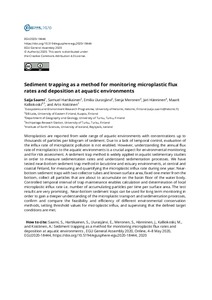Sediment trapping as a method for monitoring microplastic flux rates and deposition at aquatic environments
Senja Meronen; Arto Koistinen; Emilia Uurasjärvi; Maarit Kalliokoski; Samuel Hartikainen; Jari Hänninen; Saija Saarni
https://urn.fi/URN:NBN:fi-fe2021042827266
Tiivistelmä
Microplastics are reported from wide range of aquatic environments with concentrations up to thousands of particles per kilogram of sediment. Due to a lack of temporal control, evaluation of the influx rate of microplastic pollution is not enabled. However, understanding the annual flux rate of microplastics to the aquatic environments is a crucial aspect for environmental monitoring and for risk assessment. A sediment trap method is widely applied in aquatic sedimentary studies in order to measure sedimentation rates and understand sedimentation processes. We have tested near-bottom sediment trap method in lacustrine and estuary environments, at central and coastal Finland, for measuring and quantifying the microplastic influx rate during one year. Near-bottom sediment traps with two collector tubes and known surface area, fixed one meter from the bottom, collect all particles that are about to accumulate on the basin floor of the water body. Controlled temporal interval of trap maintenance enables calculation and determination of local microplastic influx rate i.e. number of accumulating particles per time per surface area. The test results are very promising. Near-bottom sediment traps can be used for long term monitoring in order to gain a deeper understanding of the microplastic transport and sedimentation processes, confirm and compare the feasibility and efficiency of different environmental conservation methods, setting threshold values for microplastic influx, and supervising that the defined target conditions are met.
Kokoelmat
- Rinnakkaistallenteet [19207]
